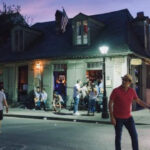While slasher films have become a dominant force in the horror genre, often relying on predictable formulas of masked killers and teenage victims, their capacity to truly frighten can be limited. Many fall into tropes that evoke disgust rather than genuine fear. However, the realm of horror truly excels when it delves into the distortion of reality, blurring the lines between what is real and what is not. Although even this subgenre can fall prey to clichés, particularly the overused dream sequence trope, Wes Craven’s “A Nightmare on Elm Street” (1984) stands out as a brilliantly innovative exception.
Alt text: Nancy Thompson wide-eyed and fearful in her bed, a scene depicting dream-induced terror from A Nightmare on Elm Street.
The typical dream sequence in horror films often involves a character jolting awake in a cold sweat, a convention so overused it borders on parody. These scenes frequently serve as jump scares or plot diversions without contributing meaningfully to the narrative. “A Nightmare on Elm Street” masterfully subverts this trope, creating a fresh and terrifying representation of dreams on screen.
Redefining Dreamscapes: The Genius of Craven’s Vision
Craven’s genius lies in his seamless blending of the dream world and reality. Both waking and dreaming scenes are filmed with a similar hazy, unsettling quality, making it perpetually unclear whether characters are awake or asleep. The film cleverly avoids depicting characters falling asleep, maintaining a constant state of unease. Every blink, every moment of closed eyes, becomes fraught with potential danger. Crucially, “Nightmare on Elm Street” blurs the distinction between reality and nightmare to the point of irrelevance. The film’s central premise – a child killer who invades and kills teenagers in their dreams – inverts the comforting “it was all just a dream” cliché. In this terrifying world, the waking world is the illusion of safety, while the dream world is where true, monstrous danger resides.
Alt text: Close-up of Freddy Krueger’s razor-sharp glove, emphasizing the nightmarish weapon in A Nightmare on Elm Street.
Iconic Scenes and Subversive Techniques
“A Nightmare on Elm Street” is replete with scenes that explore this terrifying ambiguity. The bathtub scene, for instance, cleverly evokes Hitchcock’s “Psycho” shower scene, but it’s far from a simple imitation. It builds suspense and dread in its own right, playing on the vulnerability of Nancy (Heather Langenkamp) even in a seemingly safe space.
However, the classroom scene stands out as a particularly chilling example of Craven’s mastery. Nancy’s brief doze during a Shakespeare recitation subtly transitions from the mundane classroom to a nightmarish distortion of the same setting. This seamless shift highlights the film’s core strength: the terror of anticipation.
Alt text: Nancy Thompson begins to fall asleep in class, visually foreshadowing the terrifying nightmare classroom transformation in A Nightmare on Elm Street.
Craven expertly understood that the anticipation of horror is often more potent than the horror itself. Visual cues, such as Freddy’s unnaturally elongating arms in the alleyway or the stairs turning into a viscous, inescapable substance, tap into primal nightmare anxieties. The film consistently teases the audience, building tension through creative and unsettling imagery, avoiding the cheap jump scares and red herrings common in lesser slasher films.
Flaws and Enduring Legacy
Despite its innovative approach to dream horror and genuinely frightening sequences, “A Nightmare on Elm Street” isn’t without its shortcomings. The characters, while functional, are relatively one-dimensional, and the performances, while adequate, don’t reach extraordinary heights. Johnny Depp, in his debut role as Nancy’s boyfriend, Glen, delivers some memorable lines, particularly his “dream skills” exposition, but his character remains underdeveloped, a far cry from the acting prowess he would later demonstrate.
Furthermore, the film’s ending is undeniably weak and confusing. Clearly designed to facilitate sequels, it introduces a perplexing ambiguity that subsequent films struggled to resolve. The final confrontation between Nancy and Freddy feels anticlimactic, and her father’s strangely passive behavior in this scene adds to the confusion. The concluding scene, while intended to be a final scare, falls flat and feels unnecessary, almost undermining the film’s overall impact.
Despite these flaws, particularly the clumsy ending, “A Nightmare on Elm Street” remains a landmark horror film. Its innovative exploration of dream logic, Craven’s masterful direction, and genuinely terrifying sequences elevate it far beyond typical slasher fare. It’s a film that lingers in the mind, prompting repeat viewings and solidifying its place as a true horror classic that continues to haunt our collective nightmares.

